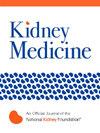按种族/民族和疫苗接种状况划分的美国透析患者COVID-19住院和死亡率趋势
IF 3.4
Q1 UROLOGY & NEPHROLOGY
引用次数: 0
摘要
基本原理及2019冠状病毒病(COVID-19)大流行对包括肾脏疾病患者在内的弱势群体的影响尤为严重。我们阐明了在大流行之前和期间接受维持性透析的个体的住院和死亡率的纵向趋势,并探讨了疫苗的普遍可用性如何按种族/民族影响COVID-19结局。研究设计:回顾性队列研究。设置,参与者:2018-2023年在美国一家全国性非营利机构接受成人维持性透析的患者。预测2019冠状病毒病时代(2020-2023),种族/民族。covid -19疫苗接种状况;住院和死亡(与covid有关,全因)。分析方法使用零膨胀泊松模型和logistic回归模型分别计算住院率和死亡率,并根据年龄、性别、种族/民族、透析时间和合并症的数量进行调整。结果在41257例接受维持性透析的患者中,全因住院率在2020年3月/ 4月突然下降,此后有所上升,但仍低于大流行前的水平。在2018-2019年期间,全因死亡率表现出典型的季节性变化,随后随着2020年3月COVID-19大流行的爆发而增加。死亡率在2021年1月达到峰值,为每1000人年228人死亡,然后在2021年3月降至每1000人年151人死亡。随后,在三角洲变异和欧米克隆变异期间,死亡率短暂上升,峰值分别为每1 000人年死亡188人和189人。此后,全因死亡率仍低于大流行前的水平。在2021年广泛提供SARS-CoV-2疫苗并在透析设施提供疫苗后,所有种族/族裔群体的COVID-19死亡率显着下降(b = - 5.3;P & lt;0.001)。在每年年底,不同种族/民族的疫苗接种状况没有统计学上的显著差异。潜在残留混杂因素和少报covid -19相关结果。结论:2020年和2021年初,全因死亡率急剧上升,反映出与covid -19相关的死亡,而非covid -19死亡率在大流行早期有所下降,随后仍低于大流行前的水平。在引入SARS-CoV-2疫苗后,全因死亡率下降到大流行前的水平以下,这可能反映了在透析人群中广泛接种疫苗的影响。本研究评估了美国全国透析队列在2019冠状病毒病(COVID-19)大流行之前和期间的死亡率、住院率和疫苗接种状况的趋势。在41257名患者中,尽管全因死亡率上升,但全因住院率在2020年3月突然下降,恰逢疫情开始时全国封锁。在2021年获得COVID-19疫苗后,所有种族/族裔的COVID-19相关死亡率均显着下降,各种族/族裔的透析患者的疫苗接种率相似。维持性透析患者对COVID-19严重后果的持续脆弱性突出表明,需要在最方便的地点保持普遍获得疫苗,同时促进持续更新疫苗状况,以限制这一高危人群中与COVID-19相关的住院和死亡。本文章由计算机程序翻译,如有差异,请以英文原文为准。
COVID-19 Hospitalization and Mortality Trends Among US Dialysis Patients by Race/Ethnicity and Vaccination Status
Rationale & Objective
The coronavirus disease 2019 (COVID-19) pandemic disproportionately affected vulnerable individuals, including people with kidney disease. We elucidated longitudinal trends in hospitalization and mortality among individuals receiving maintenance dialysis before and during the pandemic and explored how universal vaccine availability affected COVID-19 outcomes by race/ethnicity.
Study Design
A retrospective cohort study.
Settings & Participants
Adult maintenance dialysis patients between 2018-2023 at a national not-for-profit US provider.
Predictors
COVID-19 era (2020-2023), race/ethnicity.
Outcomes
COVID-19 vaccination status; hospitalization and death (COVID-related, all-cause).
Analytical Approach
Zero-inflated Poisson models and logistic regression models were used to calculate hospitalization and mortality rates, respectively, adjusted for age, sex, race/ethnicity, dialysis vintage, and number of comorbid conditions.
Results
Among 41,257 patients receiving maintenance dialysis, all-cause hospitalization dropped abruptly in March/April 2020 and increased thereafter, albeit remaining below prepandemic rates. All-cause mortality exhibited typical seasonal variability during 2018-2019, subsequently increasing with onset of the COVID-19 pandemic in March 2020. Mortality peaked in January 2021 at 228 deaths per 1,000 person-years before declining to 151 deaths per 1,000 person-years in March 2021. Subsequently, mortality transiently increased during the Delta and Omicron variant periods, peaking at 188 and 189 deaths per 1,000 person-years, respectively. Thereafter, all-cause mortality remained below prepandemic levels. After widespread SARS-CoV-2 vaccine availability in 2021 with vaccine provision in dialysis facilities, the COVID-19 mortality rate among all race/ethnicity groups declined significantly (b = −5.3; P < 0.001). There were no statistically significant differences by race/ethnicity in the vaccination status at each year’s end.
Limitations
Potential residual confounders and underreporting of COVID-19–related outcomes.
Conclusions
All-cause mortality increased sharply in 2020 and early 2021, reflecting COVID-19-related deaths, whereas non–COVID-19 mortality declined during the early phase of the pandemic and subsequently remained below prepandemic levels. After introduction of SARS-CoV-2 vaccines, all-cause mortality declined to below prepandemic levels, likely reflecting the impact of widespread vaccination in the dialysis population.
Plain-Language Summary
This study evaluated trends for mortality, hospitalization, and vaccination status, before and during the coronavirus disease 2019 (COVID-19) pandemic in a national US dialysis cohort. Among 41,257 patients, all-cause hospitalization rates abruptly dropped in March 2020 despite an increase in all-cause mortality, coinciding with the national lockdown when the pandemic began. COVID-19–related mortality dropped significantly among all races/ethnicities after the availability of COVID-19 vaccines in 2021, with similar vaccination rates for dialysis patients attained across racial/ethnic groups. The continued vulnerability of patients on maintenance dialysis to severe COVID-19 outcomes highlights the need to maintain universal access to vaccines at their most convenient venue while promoting continuous updated vaccine status to limit COVID-19–related hospitalization and death in this high-risk population.
求助全文
通过发布文献求助,成功后即可免费获取论文全文。
去求助

 求助内容:
求助内容: 应助结果提醒方式:
应助结果提醒方式:


